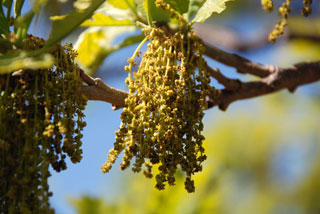BUR OAK
|
 |
| File Size: 86 KB |
|
|
|
Quercus macrocarpa Michx. var. macrocarpa
|
| Konza Prairie, Riley County, Kansas |
| Height: 40 to 100 feet |
| Family: Fagaceae - Oak Family |
| Flowering Period: April, May |
|
| Trunks: | | Short, 20-60 inches in diameter; crown broad; bark dark gray, ridges long and flat-topped or short and blocky; branches horizontal, angular, rugged; branch bark with corky ridges. | | Twigs: | | Stiff, coarse; bark yellowish-brown or ashy-grey, usually woolly; leaf scars large, half-round, somewhat elevated; bundle scars 10 or more, scattered; buds egg-shaped, reddish-brown. | | Leaves: | | Alternate, simple, deciduous, egg-shaped to oblong, often fiddle-shaped, 6-10 inches long, 2.4-6 inches wide, thick, leathery; upper surface dark green, shiny; lower surface pale, pubescent; margins unevenly 5-7-lobed; lobes rounded; terminal lobe largest; lateral lobes often with deep, opposite sinuses near mid-leaf; sometimes shallow-lobed to nearly entire on deep shade branches; base wedge-shaped to round; stalk stout, .4 to 1.2 inch long. | | Flowers: | | Late April-May, with leaves; monoecious (male and female flowers on same tree); staminate in slender, drooping catkins 2.8 to 4+ inches long, on previous year's twigs; staminate flowers greenish-brown; stamens several; anthers yellow; pistillate flowers inconspicuous, sessile or short-stalked, in groups of 1-4, clustered at base of leaves; flowers globular, 1/12 to 1/10 inch in diameter, often reddish; calyx 4-6-lobed, downy; corolla absent; stigma 3-lobed. | | Fruit: | | Autumn of first season; acorns 1-3, variable in size and shape, 1-seeded; sessile or short-stalked; cup hemispheric, often deep, 1 to 1.2 inch tall, 1.4 to 1.8 inch wide, enclosing 1.2 to 2/3 or more of nut; cup scales rough, closely appressed, gray-woolly; cup rim fringed, awns .2 to .4 inch long; nut broadly egg-shaped, .4 to 1.6 inch long and wide, brown, finely pubescent; outer end rounded; base flattened. | | Habitat: | | Stream banks, prairies, riparian slopes, bottom lands in west, upland slopes in east; usually on limestone or calcareous clay soils. | | Distribution: | | East 2/3 of Kansas | | Origin: | | Native | | Uses: | | Native Americans boiled the bark and took the liquid to treat cramps and diarrhea and boiled the inner bark and combined it with black earth to make a black dye. The bark was also used by some tribes to splint broken legs. The acorns were used as food, roasted or boiled, and were chopped up and cooked in soups and with meats. A number of Great Plains tribes leeched the acorns with basswood ashes to remove the bitter taste. | | Comments: | | An ornamental and lumber tree. Long-lived. Some Kansas specimens are estimated to be 300-400 years old. Highly cold-tolerant. Wood is hard, heavy, strong, brown; very durable. |
|
| Bur oak staminate cakins |  | | 106 KB | | Konza Prairie, Riley County, Kansas |
| | Bur oak |  | | 176 KB | | Konza Prairie, Riley County, Kansas |
| | Bur oak |  | | 160 KB | | Konza Prairie, Riley County, Kansas |
| | Bur oak bark |  | | 78 KB | | Geary County, Kansas |
| | Bur oak leaves |  | | 86 KB | | Geary County, Kansas |
| | Bur oak leaves |  | | 115 KB | | Geary County, Kansas |
| | Bur oak leaves |  | | 74 KB | | Geary County, Kansas |
| | Bur oak acorn |  | | 86 KB | | Konza Prairie, Riley County, Kansas |
| | Bur oak acorns and leaves |  | | 127 KB | | Konza Prairie, Riley County, Kansas |
| | Bur oak buds |  | | 26 KB | | Konza Prairie, Riley County, Kansas |
| | Bur oak leaf scar and buds |  | | 34 KB | | Konza Prairie, Riley County, Kansas |
| | Bur oak pistillate flowers |  | | 57 KB | | Konza Prairie, Riley County, Kansas |
| | Bur oak pistillate flowers |  | | 35 KB | | Konza Prairie, Riley County, Kansas |
| | Bur oak fruit |  | | 90 KB | | Konza Prairie, Riley County, Kansas |
| | Bur oak in winter |  | | 194 KB | | Konza Prairie, Riley County, Kansas |
| | Bur oak habit |  | | 175 KB | | Konza Prairie, Riley County, Kansas |
| | Bur oak leaves and acorn |  | | 209 KB | | Ellsworth County, Kansas |
| | | |
|
|
|